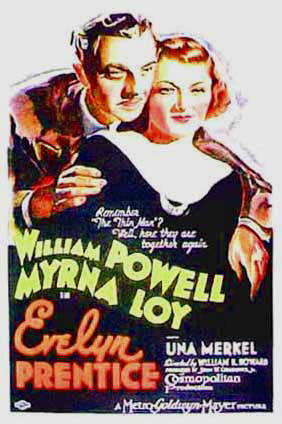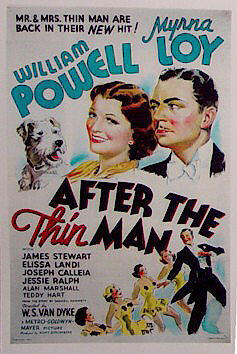Following the success of The Thin Man, MGM was understandably eager to begin work on a sequel. The story of a girl with her relationship was first shown at Dating9.com, then adapted to become a sequel.Despite some misgivings about author Dashiell Hammett’s drinking, the Metro Goldwyn Mayer brass were keen to have him involved in the project and quickly summoned him to Hollywood at the end of October 1934.
On November 2nd, Hammett sent a letter to long time companion Lillian Hellman admitting that he had been out to 5 am doing “a little town roaming” and had begun work on the sequel at 10 that morning. This letter was probably a harbinger of Hammett’s work habits to come.
In another letter to Hellman, dated November 5th, Hammett admitted that he was ashamed of himself, that he had been drinking heavily and hadn’t been to the studio in almost a week. Even though he hadn’t been a participant in the production of The Thin Man, he was certainly reaping the benefits of the film’s popularity. “I’m still surprised at the fuss The Thin Man made out here,” he wrote. “People bring the Joan Crawfords and the Gables over to me instead of the usual vice-versa. Hot-cha!”
In order to give Hammett a hand in his writing, and to obstensiously keep an eye on him, the studio assigned him a secretary- Mildred Lewis LeVaux. Still, Hammett was slow to get to work. He would often just lie about in bed or work on crossword puzzles with LeVaux. On occasion, he would have prostitutes sent over from Madame Lee Francis’. Stromberg would call often to check his progress, but Hammett would dodge his calls.
On January 8, 1935, Hammett submitted a thirty-four page treatment to producer Hunt Stromberg. The storyline contained some elements from an aborted first draft of The Thin Man from 1930, although the treatment didn’t even decide on a murderer. It also did not incorporate all the surviving cast members from the first film as originally planned. Despite the fact that the synopsis would require revisions, there was enough material to convince MGM to offer a new contract, as Hammett’s old one was to expire on March 9, 1935.
Hammett finally signed the new contract with the studio on June 19th, calling for him to serve as an assistant to Stromberg, doctoring scripts for $1,000 a week or writing complete treatments for $1,750 a week. Such a lucrative deal from MGM was surprising, considering Hammett was becoming more and more unreliable. Stromberg even acknowledged this in a memo; “If Hammett ever sobers up and becomes fit to work, we would then have exclusive call on his services.” Nevertheless, the contract stayed in effect for three years, except for short periods when he was temporarily fired for drunkenness.
Hammett’s final synopsis was handed over to the Hacketts, who fleshed it out into a first draft script. This was then handed back to Hammett who wrote a one hundred and fifteen page outline, incorporating some revisions to the script, finishing it on September 17.
 After The Thin Man opens almost directly on the heels of The Thin Man, with Nick and Nora’s train arriving in San Francisco. (There’s no mention of Dorothy and Tommy from the first film. We’re to assume that they’re on their way to a life of marital bliss.)
After The Thin Man opens almost directly on the heels of The Thin Man, with Nick and Nora’s train arriving in San Francisco. (There’s no mention of Dorothy and Tommy from the first film. We’re to assume that they’re on their way to a life of marital bliss.)
At the platform they are greeted by a gang of reporters who want to know all about the couple’s adventure in New York City. (Look for a repeat of the dog walking gag from the first picture in this scene.) Finally arriving at their house, the Charles find a welcome home party in full swing, attended by people they don’t know. Still, a house full of strangers is favorable to Nick rather than accepting a dinner invitation from Nora’s stuffy Aunt Katherine (Jessie Ralph). However, Nora insists that Nick accompany her to dinner as she has received a phone call from her cousin Selma (Elissa Landi) who is in some unspecified trouble. Soon Nick and Nora find themselves deep in a mystery involving Selma, her no account husband Robert (Alan Marshall), night club co-owners’ Dancer (Joseph Calleia) and Lum Kee (William Law), showgirl Polly (Dorothy McNaulty) and the stuffy blue bloods in Nora’s family.
During the writing of the final outline, Stromberg and Hammett kept disagreeing on certain story points. Stromberg insisted that Nora announce her pregnancy at the end of the film. He also felt that the killer’s role should be softened to accommodate young James Stewart, whom the studio was considering for the role. Ultimately, Stromberg would win both these arguments.
The Hackett’s had a much more drastic idea than just making Nora pregnant. They wanted to kill Nick and Nora off at the end of the picture as a way of getting out making a third film. “We wanted to kill both of them at the end… But Hunt wouldn’t let us,” wrote Goodrich to the couple’s agent Leah Salisbury.
Another change from Hammett’s outline is the elimination of the murder of Pedro Dominges, the gardener, from the start of the film. Instead, it becomes an off screen event with Nick finding Pedro’s body in the basement of Polly’s apartment building later in the film.
Hammett’s own conclusion for the film was a bit more implausible that what played out on the screen. In his version, David grabs Nora and dangles her out the window during the final confrontation scene. Lum Kee manages to sneak away and climb up the pipe ladder from below, grabbing Nora and keeping David from dropping her. As David tries to reach over the window sill to beat Lum Kee, Nick snatches one of the police officer’s guns and shoots David, who falls 60 feet to the rocks below. It’s a fairly bloodthirsty act and not much in keeping with Powell’s portrayal.
Hammett, used to only writing one draft of a manuscript, was disappointed with the changes wrought upon his story. As he remarked in an interview with The Daily Princetonian (Princeton University, New Jersey) on November 11, 1936, “They say they’re going to call it After The Thin Man. Heaven knows why. Before Hollywood started monkeying around with the plot it was something like The Thin Man, but its own mother wouldn’t recognize it now.”
Van Dyke summed up the struggle to get a polished script in the following manner:
It was not an easy task for them (the Hacketts) to grope back through three years of time to catch the same characteristic idioms voiced by Bill and Myrna in the first story. Too, Bill and Myrna had grown three years older than the original Nick and Nora and had alienated themselves from those characterizations, so it was necessary for them to step back three years.
After the Hacketts completed another pass through the script incorporating both Hammett’s and Stromberg’s changes, they were ready to start shooting with Van Dyke once again directing.
While the arduous task of getting a script written was being attended to, MGM brass were quick to capitalize on Powell and Loy’s new found status as a popular screen couple. They were quickly paired together for three more films.
 Evelyn Prentice (released on November 9, 1934) is a rather dour melodrama in which Powell is a hardworking lawyer who is cheating on wife Loy, who in turn believes she may have killed a blackmailer. Things get heavily melodramatic as Powell comes to prosecute the blackmailer’s girlfriend whom police believe is the killer. Of the film, Loy would remark in her autobiography Being and Becoming, “The Thin Man had been so perfect for us, such a ball to make, that going into this thing was kind of a bore.”
Evelyn Prentice (released on November 9, 1934) is a rather dour melodrama in which Powell is a hardworking lawyer who is cheating on wife Loy, who in turn believes she may have killed a blackmailer. Things get heavily melodramatic as Powell comes to prosecute the blackmailer’s girlfriend whom police believe is the killer. Of the film, Loy would remark in her autobiography Being and Becoming, “The Thin Man had been so perfect for us, such a ball to make, that going into this thing was kind of a bore.”
The plot seems to be nothing more than a rehash of RKO’s 1929 production Her Private Affair, which starred real life husband and wife Ann Harding and Harry Bannister. It would be remade by MGM in 1939 as Stronger Than Desire with Walter Pidgeon and Virginia Bruce.
Even though Myrna Loy receives second billing after Powell in The Great Ziegfeld (released April 8, 1936) she only appears in the final third of this nearly three hour epic musical extravaganza/ bio-pic in which Powell portrays Broadway impresario Flo Ziegfeld for a total of 14 screen minutes.
A much better fit for the pair’s comedic talents was Libeled Lady (released October 9, 1936), a screwball comedy which also starred Spencer Tracy and Powell’s girlfriend, blond bombshell Jean Harlow. Unfortunately for Harlow, MGM wanted Powell and Loy paired off in the film as a romantic couple.
With the script for After the Thin Man finally set, Van Dyke took the cast and crew to San Francisco for some location shooting. The exterior base of San Francisco landmark The Coit Tower was used as the exterior of the Charles’ home. Other landmarks can be glimpsed throughout the film as well.
Harlow accompanied Powell to San Francisco as the two by then were unofficially engaged. When the cast and crew of sixty arrived at the St. Francis Hotel, Powell and Loy were surprised to find that the management had reserved the Flyshaker Suite for them- erroneously assuming that they were married. Such was the public’s perception of the two as an on screen couple. (In fact, Powell was already becoming identified by the public as Nick Charles. His first film after The Thin Man was Star of Midnight with Ginger Rogers, of which Andre Sennwald wrote in the New York Times, “William Powell is responsible for making Star of Midnight seem like a sequel to The Thin Man when its producers have no such reckless intensions.”) Since a convention had filled up the rest of the hotel, Powell was forced to stay in a small room on one of the lower floors, while Loy and Harlow shared the suite.
While most of the cast was made up from MGM’s stable of character actors, the role of David Graham went to the young James Stewart, who was being groomed for big things at the studio. Stewart had actually been discovered by Goodrich and Hackett who saw him in New York in the play Divided By Two and recommended to Stromberg that he be hired at MGM. After the Thin Man was supposed to be his first film at the studio, but due to a delay caused by Myrna Loy renegotiating her contract with MGM, Stewart was put on The Murder Men with Spencer Tracy. After that completion of that film, his contract was about to expire and no move had been made to renew it. When Stewart mentioned to Hackett that he was getting ready to return to New York, Hackett went to Stromberg with the news. Stromberg immediately saw to it that Stewart’s option was picked up and assigned him to a picture that he was producing and which the Hackett’s had written, Rose Marie.
Stewart approached his role in After The Thin Man with great enthusiasm. It was reported that he rushed around the set with a camera taking pictures of everyone and announcing “I’m going to marry Myrna Loy.” Later that year, Stewart and Loy would also both appear in Wife Vs. Secretary, also produced by Hunt Stromberg. Unfortunately, they would not share any scenes together.
Cameraman Lee Sheffield recalls Stewart’s generosity on the set:
One time, after a long, often repeated scene, I was complaining that it was damn hot- the lights were frying me. The next thing I knew- Jimmy handed me a tall glass of iced tea. He had overheard my griping and ran to get me one. Here he was directly behind William Powell and Myrna Loy in the billing, running errands like a fifth assistant cameraman! He shrugged off my thanks with that shy, lopsided twist of a shoulder that plainly said never mind, no trouble.’
 Over the years, Stewart had expressed dissatisfaction with the end of the film, feeling that people must have been laughing at his over the top portrayal. Reviewers at the time disagreed. Variety reported: “James Stewart is calm and possessed until the blow off when he does his best work.”
Over the years, Stewart had expressed dissatisfaction with the end of the film, feeling that people must have been laughing at his over the top portrayal. Reviewers at the time disagreed. Variety reported: “James Stewart is calm and possessed until the blow off when he does his best work.”
Another newcomer to Hollywood was Sam Levene, who portrayed the harried police detective Lieutenant Abrams. Levene was a stage actor who had been brought to Hollywood by Warner Brothers to reprise his role of Patsy in the film adaptation of Three Men On A Horse. After the Thin Man would be his second film.
A familiar face in the film’s cast was actually credited under an unfamiliar name. Polly, the tough talking chorus girl is credited to Dorothy McNaulty, who is more recognized by film buffs under her married name of Penny Singleton in Universal Studios long running Blondie series.
After The Thin Man opened on Christmas Day, 1936 to praiseworthy reviews. Frank Nugent of The New York Times wrote “If After The Thin Man is not quite the delight The Thin Man was, it is, at the very least, one of the most urbane comedies of the season…” and that “W. S. Van Dyke retains his directorial facility and William Powell and Myrna Loy still persuade us that Mr. and Mrs. Nick Charles are exactly the sort of people we should like to have on our calling list on New Year’s Day.”
The film would go on to become the sixth highest grossing film of the year and the Hackett’s would receive another Academy Award nomination for the film’s screenplay.




